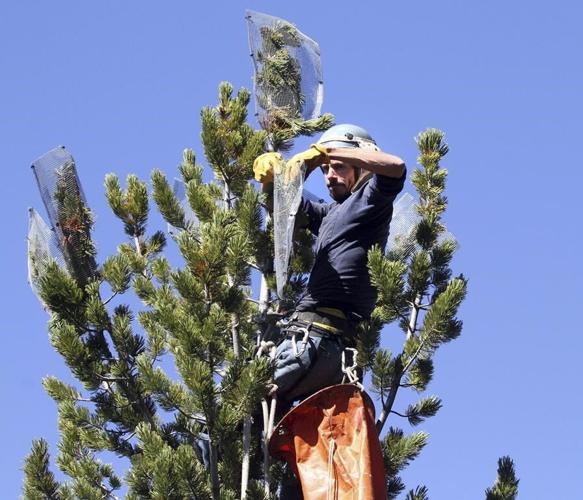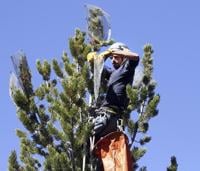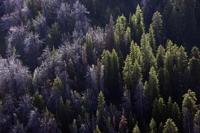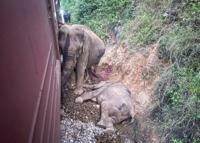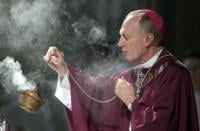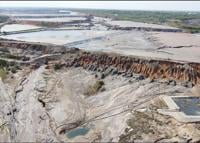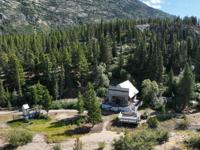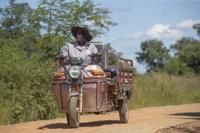BILLINGS, Mont. (AP) — Whitebark pine trees can live more than 1,000 years, but in just two decades more than a quarter of the trees that are a key food source for some grizzly bears have been killed by disease, climate change, wildfires and voracious beetles, government officials said as they announced federal protections Wednesday.
The U.S. Fish and Wildlife Service will designate whitebark pine as threatened with potential extinction, according to details obtained by The Associated Press. The belated will require officials to craft a recovery plan and pursue restoration work.
Whitebark pines are found at elevations up to 12,000 feet (3,600 meters) — conditions too harsh for most tress to survive. They are considered a “keystone” species other plants and animals depend on for survival, and their edible seeds are spread almost exclusively by a bird, the Clark's nutcracker.
A nonnative fungus — white pine blister rust — has been killing whitebark pines for a century and they've been largely wiped out in areas. That includes the eastern edge of Yellowstone ���ϳԹ��� Park, where seeds from the trees are a source of food for threatened grizzly bears.
More recently, the trees have proven vulnerable to bark beetles that have killed millions of acres of forest, and that scientists say is responsible for more severe wildfire seasons.
The trees occur across 126,000 square miles (326,164 square kilometers) of land in Wyoming, Montana, Idaho, Washington, Oregon, California, Nevada and western Canada.
Wildlife officials declined to designate which forest habitats are critical to the tree’s survival, stopping short of what some environmentalists argue is needed.
An estimated 88% of whitebark pine habitat is federally owned, with most of that area managed by the U.S. Forest Service.
Just over 50% of standing whitebark pine trees are dead, according to researchers. That includes about 25% that died in the past two decades, said Alexandra Kasdin with the U.S. Fish and Wildlife Service.
Despite the losses, remaining whitebark populations are resilient enough to withstand disease and other problems for decades, she said.
“We have found it is likely to become endangered with extinction in the foreseeable future, not that it is in danger of extinction now,” Kasdin said. “The species is still relatively widespread.”
Noah Greenwald with the Center for Biological Diversity said the decision not to designate critical habitat means whitebark stands could be harmed by construction of ski areas or other developments.
“How it’s going to be able to survive in a warming world isn’t totally known, so it would be prudent to identify places likely to be refuges and ensure they get protected,” Greenwald said.
The species is not commercially harvested, but California wildlife officials said timber harvests should nevertheless be considered a threat in areas where whitebark pine are intermingled with other trees. Federal officials said logging could affect individual trees or local areas, but was unlikely to have species-level impacts.
A 2009 court ruling that restored protections for Yellowstone grizzly bears cited in part the tree’s decline, although government studies later concluded the grizzlies could find other things to eat.
That's complicated government efforts to declare the bears recovered and no longer needing federal protection. Grizzlies raid caches of whitebark pine cones hidden by squirrels and devour the seeds within the cones to fatten up for winter.
Environmentalists had petitioned the government in 1991 and again in 2008 to protect the trees. After getting sued, wildlife officials in 2011 acknowledged that whitebark pines needed protections but they took no immediate action, saying other species faced more immediate threats.
At the time many mountaintops across the West were turning red with dying stands of whitebark pine, said 2008 petition author Sylvia Fallon, a Natural Resources Defense Council biologist.
“Now you look up at the mountains and you see fields of gray, dead trees,” Fallon said Wednesday. “It's taken 14 years since we filed the petition, but I'm glad to see Fish and Wildlife finally make this determination."
The protections adopted Wednesday were proposed two years ago. The final rule includes new provisions that allow members of Native American tribes to collect seeds from whitebark pine for ceremonial or traditional use.
Researchers and private groups are working with federal agencies on plans to gather cones from blister rust-resistant trees, grow the seeds in greenhouses and then plant them back on the landscape.
“There's hope here,” said Diana Tomback, a University of Colorado Denver biology professor and policy director for the Whitebark Pine Ecosystem Foundation.
“We know how to find genetic resistance to white pine blister rust and there's a number of whitebark pine trees that have it. They will be the foundation of a planting strategy,” she said.
A draft of the restoration plan is expected early next year.
Some work already has been accomplished, including the planting of nearly 1 million disease resistant seedlings by the advocacy group American Forests, said Elizabeth Pansing the group's senior manager of western forest science. So far that work “is not happening at the pace or scale needed” to accomplish range-wide restoration, Pansing said.
Future efforts will seek to reseed about a third of the whitebark pine’s range in coming years, Pansing said. Clark's nutcrackers would then spread seeds from disease-resistant trees across the remainder of the range, according to Pansing and Tomback.
“It may take several human lifetimes, but eventually through natural processes we believe we can restore whitebark pine,” Tomback said.
___
On Twitter, follow Brown @MatthewBrownAP

